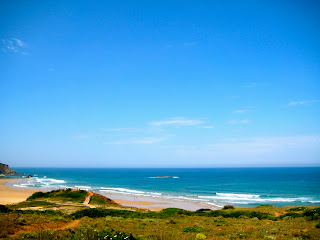Seville
I begin my journey abroad in one of the most incredible countries in the world. Rich in history, culture, architecture and let’s not forget the delectable cuisine, Spain is definitely a country worth visiting at least once in your life.
Located in the southwest part of the Iberian Peninsula is Seville, the capital of Andalusia and one of the most beautiful cities in all of Spain. It is the fourth largest city in Spain with a population of a little over 700,00 people and it is considered the artistic, cultural, financial, economic and social center of southern Spain.
Seville’s Mediterranean climate, which includes mild winters, hot summers and slight rain throughout the whole year, make this city’s climate almost perfect in every season.
The renowned cuisine of Seville focuses on the simplicity of its recipes. The bold flavors from a myriad of condiments make all meals something to look forward to. Tapas are one of the many attractive features of Seville's cuisine as a result of the region being the origin of this appetizer tradition. Tapas are miniature dishes which people tend to eat at all times usually at bars, accompanied by some great tasting wine or sangria as well as jerez, or sherry. Within the province of Sevilla you can find the small city of Jerez, responsible for supplying the entire world with genuine sherry.
Seville is a city where you will be very much enveloped by Andalusian culture, where tauromachy, or bullfighting, and flamenco are a way of life. It is a city where you are encouraged to “take it easy” and enjoy every aspect of its mesmerizing culture, from the tapas, to the breathtaking architecture.
Seville is especially famous for its monumental and artistic heritage of great beauty and historical importance. There are very few cities in the world that continue to flaunt the incredible combinations of architectural styles.
Some of the major sites and most symbolic for Seville in the world include the Catedral de Sevilla and Giralda Tower, the Alcazar, and the Casa de Pilatos.
Catedral de Sevilla and Giralda Tower
The Catedral de Sevilla is the most important church in the Andalusian metropolis. Also known as the Catedral de Santa Maria de La Sede, it is the largest cathedral in Spain and the third largest in the world. Like many major churches in Spain, this Gothic-style architecture was built on the site of an old mosque in the early 15th century. It is also the location of Christopher Columbus’ tomb.
The Giralda Tower is the minaret, or bell tower, of the old mosque on which the cathedral was built on. It’s Moorish-looking style has been preserved and is significantly different from the gothic style of the cathedral. This architectural masterpiece dates from the 12th century and is considered one of the most significant remnants of Seville's Moorish legacy. It was once the tallest tower in the world and today, after three additions made after the conquest, we see the final tower, 97.5 meters high, topped with a bronze weathervane.
A mixture of Islamic and European traditions, this combination is best represented in the magnificence of the Real Alcázar, a palace still in use by members of the Spanish royal family and considered the oldest inhabited palace in Europe. There have been numerous transformations of power between the Christians and the Muslims. The Christian roots of Seville date back to the 1st century and Christian dominion continued until the Moorish conquest in the year 712 AD. After this, Islam was the dominant force. The Moorish Almohaden chose Seville as their main residence and with it hand down a great heritage, evidence of their extraordinary culture. The Real Alcazar is ornate and majestic and has breathtaking gardens where tourist can have picnics and spend the day.
The Casa de Pilatos is the most magnificent palace that can be visited in Sevilla, after the Real Alcazar. It is interesting not only for its architecture, which combines styles of Mudejar and Renaissance in its courtyards, fountains, and salons, but also displays Roman antiquities from the ruins of Italica, and paintings and furniture from different periods of time. According to tradition, this palace is a reproduction of Pilate's house in Jerusalem. Today it is the residence of the Dukes of Medinaceli.
Seville is an alluring city that will certainly capture your senses, where your eyes will be mesmerized with a cityscape extremely rich in history and art, your taste buds will be engulfed in exquisite fare and exceptional drinks and your mind will wonder why you didn’t come sooner.















































